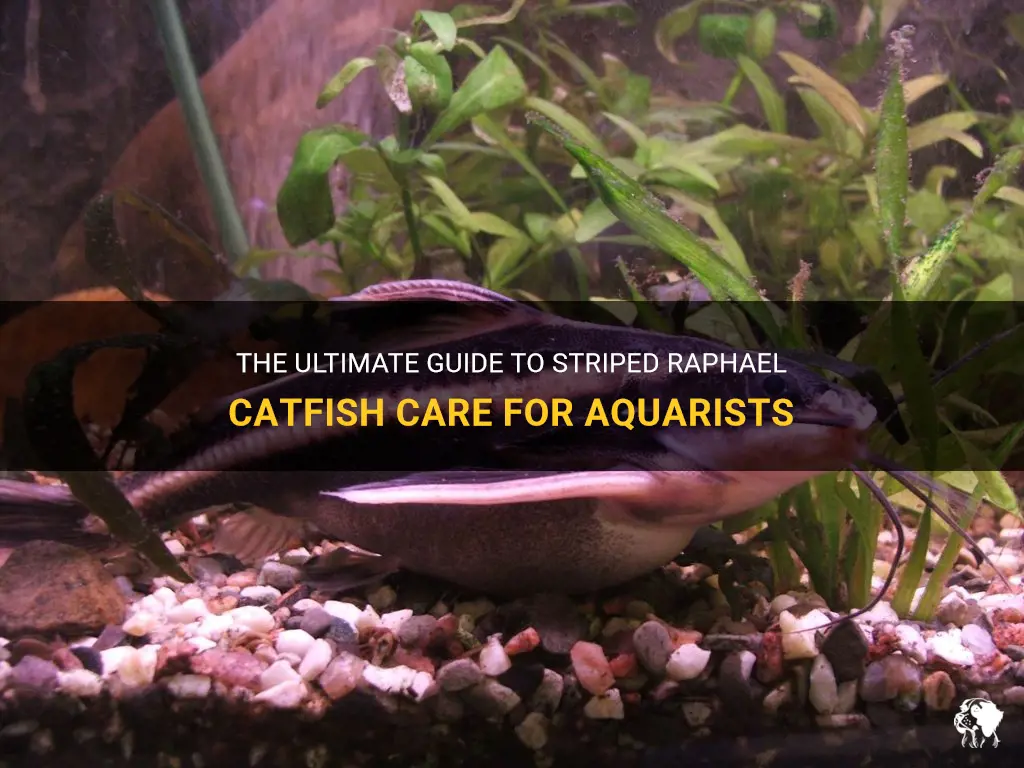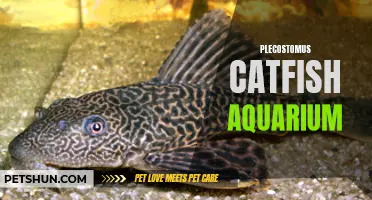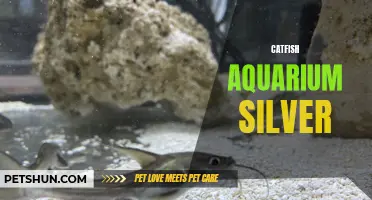
Are you looking to add a unique and eye-catching fish to your aquarium? Look no further than the striped Raphael catfish! Known for their distinctive striped pattern and fascinating behavior, these catfish make for an intriguing addition to any tank. However, caring for these striped beauties requires some specific knowledge and attention to their needs. In this article, we will guide you through the ins and outs of striped Raphael catfish care, ensuring that you provide the optimal environment for these captivating creatures to thrive in.
| Characteristics | Values |
|---|---|
| Scientific Name | Platydoras armatulus |
| Common Name | Striped Raphael Catfish |
| Family | Doradidae |
| Origin | South America, Amazon Basin |
| Size | Up to 6 inches |
| Lifespan | 8-10 years |
| Temperament | Peaceful |
| Tank Size | 30 gallons or larger |
| Water Parameters | pH 6.5-7.5, temperature 72-82°F |
| Water Hardness | Soft |
| Diet | Omnivorous, primarily carnivorous |
| Feeding Frequency | 1-2 times a day |
| Tank Mates | Peaceful community fish |
| Habitat and Decor | Provide hiding places, driftwood, and plants |
| Water Quality and Filtration | Good filtration and regular water changes |
| Breeding | Difficult in captivity |
| Common Health Issues | White spot disease, fin rot |
| Special Considerations/Requirements | Nocturnal, prefers dim lighting |
What You'll Learn
- What are the key requirements for caring for a striped Raphael catfish?
- What type of water conditions do striped Raphael catfish prefer?
- How often should a striped Raphael catfish be fed, and what should its diet consist of?
- Are there any specific tank mates to avoid when keeping striped Raphael catfish?
- What are some common health issues or challenges that striped Raphael catfish owners may face, and how can they be addressed?

What are the key requirements for caring for a striped Raphael catfish?
The striped Raphael catfish, also known as the chocolate doradid or chocolate catfish, is a popular species among fish enthusiasts. This fish is not just aesthetically pleasing with its unique striped pattern, but it also has a reputation for being a great addition to community tanks. However, caring for a striped Raphael catfish requires specific attention to their habitat, diet, and overall health. In this article, we will outline the key requirements for caring for these fascinating fish.
Habitat Requirements:
The striped Raphael catfish originates from the Amazon River basin, so it is important to recreate their natural environment as closely as possible. A tank size of at least 20 gallons is recommended to provide ample swimming space for these active bottom-dwellers. The tank should be well-filtered and have a sandy substrate to mimic the riverside habitat. It is also crucial to provide plenty of hiding spots such as caves, driftwood, and plants to make the catfish feel secure.
Water Conditions:
Maintaining proper water conditions is essential for the health and well-being of striped Raphael catfish. These fish prefer slightly acidic to neutral water with a pH range of 6.5 to 7.5. The water temperature should be kept between 75°F and 80°F (24°C to 27°C). Regular water testing is recommended to monitor the ammonia, nitrite, and nitrate levels to ensure a healthy environment for the fish.
Diet and Feeding:
Striped Raphael catfish are omnivorous, meaning they eat both meat and plant matter. In their natural habitat, they feed on small invertebrates, worms, insects, and plant matter. In the aquarium, they can be fed a varied diet that includes sinking pellets, frozen or live bloodworms, brine shrimp, and vegetable matter like blanched zucchini or spinach. It is important to offer a balanced diet to ensure their nutritional needs are met.
Tank Mates:
Striped Raphael catfish are generally peaceful and can coexist with a variety of tank mates. However, it is important to choose tankmates that are not aggressive or too large to avoid any potential conflicts. Suitable tank mates include other peaceful community fish like tetras, gouramis, rasboras, and smaller cichlids. Avoid keeping them with fin-nipping or aggressive species.
Maintenance and Care:
Regular tank maintenance is crucial for the well-being of the striped Raphael catfish. This includes performing partial water changes every week to maintain water quality, cleaning the filter regularly, and monitoring the overall health of the fish. It is also important to observe the catfish daily and check for any signs of illness or stress, such as loss of appetite, rapid breathing, or unusual behavior. Prompt intervention is necessary if any health issues arise.
In conclusion, caring for a striped Raphael catfish requires careful attention to their habitat, water conditions, diet, and tank mates. By providing a suitable environment and a well-balanced diet, these unique fish can thrive and become a captivating addition to any aquarium. Remember to monitor their health regularly and seek professional advice if any concerns arise. With proper care, the striped Raphael catfish can live a long and healthy life in captivity.
Your Ultimate Guide to Giraffe Catfish Care
You may want to see also

What type of water conditions do striped Raphael catfish prefer?
Striped Raphael catfish, scientifically known as Platydoras armatulus, are a popular choice for many aquarium enthusiasts. These catfish are native to South America and are known for their beautiful striped patterns and unique behaviors. To provide them with the best care possible, it's important to understand the water conditions they prefer.
The striped Raphael catfish are freshwater fish and they thrive in slightly acidic water. The pH level of the water should be between 6.5 and 7.5, with a neutral pH of 7 being ideal. It's important to regularly test the pH level to ensure it remains within the desired range. If the pH becomes too acidic or alkaline, it can cause stress and health issues for the catfish.
In terms of water temperature, striped Raphael catfish prefer a range between 75 and 80 degrees Fahrenheit (24 to 27 degrees Celsius). It's important to keep the water temperature stable and avoid sudden fluctuations, as drastic changes can stress the fish and weaken their immune system.
Another crucial factor to consider is the hardness of the water. Striped Raphael catfish prefer water with a medium hardness, ideally around 6 to 12 dGH (degrees General Hardness). It's recommended to use a water testing kit to monitor the hardness of the water regularly.
In addition to the chemical composition of the water, it's important to provide a suitable environment for the catfish. These catfish are bottom-dwellers and prefer a substrate that mimics their natural habitat. A soft sandy substrate or fine gravel is ideal, as it allows the catfish to dig and burrow comfortably.
It's also important to consider the size and layout of the tank. Striped Raphael catfish are relatively large and require enough space to swim and hide. A tank size of at least 30 gallons is recommended for a single catfish, with additional space for each additional catfish.
For the best water conditions, it's important to provide proper filtration and maintain good water quality. A good filtration system will help remove toxins, such as ammonia and nitrites, and keep the water clean and clear. Regular water changes of approximately 10-20% every 1-2 weeks are also important to maintain healthy water conditions.
When introducing new catfish to the tank, it's important to acclimate them properly. This involves slowly adjusting the temperature and pH of the water to match that of the tank. This gradual process helps reduce stress and allows the catfish to adjust more easily.
In summary, striped Raphael catfish prefer slightly acidic water with a pH level between 6.5 and 7.5. They thrive in water with a temperature of 75 to 80 degrees Fahrenheit and prefer a medium hardness of 6 to 12 dGH. Providing a suitable environment with a soft sandy substrate and enough space for swimming and hiding is also important. Maintaining proper filtration and doing regular water changes will ensure the catfish thrive in their aquatic environment.
The Ultimate Guide to Caring for Baby Bristlenose Catfish
You may want to see also

How often should a striped Raphael catfish be fed, and what should its diet consist of?
The striped Raphael catfish (Platydoras armatulus) is a popular choice among catfish enthusiasts due to its interesting striped pattern and peaceful nature. In order to keep your striped Raphael catfish healthy and thriving, it is important to provide them with a proper diet and feeding schedule.
A striped Raphael catfish is an omnivorous species, which means they can consume a variety of foods from both plant and animal sources. In the wild, they feed on insects, crustaceans, small fish, and plant matter. It is essential to replicate this natural diet as much as possible in captivity.
Ideally, you should feed your striped Raphael catfish twice a day, in the morning and evening. This feeding schedule helps mimic their natural feeding patterns and allows them to consume an adequate amount of food each day. However, it is important not to overfeed them, as this can lead to health issues such as obesity and poor water quality.
The diet of a striped Raphael catfish should primarily consist of high-quality sinking pellets or tablets specifically formulated for catfish. These pellets provide a balanced diet and contain essential nutrients and vitamins required for optimal growth and health. It is recommended to choose pellets that sink quickly, as this allows the catfish to locate and consume them easily.
In addition to pellets, it is also beneficial to provide your striped Raphael catfish with a variety of live or frozen foods. This can include bloodworms, brine shrimp, daphnia, and small insects such as crickets or mealworms. These foods offer a more natural and varied diet and can help promote optimal coloration and overall health.
When introducing new foods to your catfish, it is important to do so gradually. Start with small amounts and observe their behavior and response to the new food. If they readily consume it without any negative effects, you can gradually increase the portion size.
It is important to note that the striped Raphael catfish is a nocturnal species, meaning they are most active during the night. Therefore, it is a good idea to provide them with food shortly before turning off the aquarium lights in the evening. This ensures that they can easily locate and consume their food during their active period.
In conclusion, a striped Raphael catfish should be fed twice a day, in the morning and evening, with small portions of sinking pellets or tablets. It is also beneficial to provide a variety of live or frozen foods to supplement their diet. By following these guidelines, you can ensure that your striped Raphael catfish receives a balanced diet and remains healthy and active in your aquarium.
The Complete Guide to Goonch Catfish Care: Tips and Advice
You may want to see also

Are there any specific tank mates to avoid when keeping striped Raphael catfish?
When it comes to keeping tank mates with striped Raphael catfish (Platydoras armatulus), it is important to consider their behavior and requirements. While they are generally peaceful, there are certain tank mates that may not be compatible with them. Here are some factors to consider and some specific tank mates to avoid:
- Size and aggression: Striped Raphael catfish can grow up to 8 inches in length, so it is important to choose tank mates that are of similar size or larger. Avoid keeping them with smaller fish that can be seen as prey and may be bullied or eaten. Additionally, avoid aggressive fish species that may harass or injure the catfish.
- Bottom-dwelling species: Striped Raphael catfish are primarily bottom-dwelling fish, spending most of their time hiding in caves or under cover. It is best to choose tank mates that occupy different levels of the aquarium to avoid competition for space. Avoid species that also prefer the bottom of the tank, such as other catfish or loaches.
- Water parameters: Striped Raphael catfish prefer slightly acidic to neutral water conditions, with a pH range of 6.5 to 7.5. Avoid keeping them with species that have different water parameter requirements, as it could be stressful for both the catfish and the other fish.
- Temperament and compatibility: Striped Raphael catfish are generally peaceful and can be kept with a variety of community fish species. However, there are certain fish that may not be compatible due to differences in temperament. Avoid keeping them with overly aggressive or territorial species, as well as fin nippers that may damage the catfish's long delicate fins.
- Examples of tank mates to avoid: Some specific fish species that may not be compatible with striped Raphael catfish include:
- Aggressive cichlids: Cichlids, such as oscars or Jack Dempseys, are known for their aggression and territorial behavior. They may harass or harm the catfish, especially when they are establishing their territories or during breeding.
- Nippy or fin-nipping species: Fish species, such as tiger barbs or serpae tetras, have a tendency to nip at the fins of other fish. This can stress and injure the catfish, leading to potential health issues.
- Bottom-dwelling catfish or loaches: Keeping other bottom-dwelling species, such as Corydoras catfish or loaches, with striped Raphael catfish may result in competition for resources and territories. It is best to choose species that occupy different levels of the tank to ensure harmonious cohabitation.
When selecting tank mates for your striped Raphael catfish, it is important to research and consider the specific requirements and behaviors of both species. By choosing compatible tank mates, you can create a peaceful and harmonious community aquarium that benefits all the inhabitants.
The Complete Guide to Debauwi Catfish Care: Essential Tips and Advice for a Happy and Healthy Fish
You may want to see also

What are some common health issues or challenges that striped Raphael catfish owners may face, and how can they be addressed?
Striped Raphael catfish, also known by their scientific name Platydoras armatulus, are popular freshwater fish that are often kept in aquariums. While they are generally hardy and easy to care for, striped Raphael catfish owners may encounter a few health issues or challenges. In this article, we will explore some common health issues and challenges that striped Raphael catfish owners may face, and discuss how they can be addressed.
One common health issue that striped Raphael catfish owners may come across is poor water quality. These catfish are highly sensitive to changes in water parameters, and poor water quality can stress them out and make them more susceptible to diseases. To address this issue, it is important to regularly test the water parameters in the aquarium and make any necessary adjustments. This can be done by monitoring pH, ammonia, nitrite, and nitrate levels using test kits specifically designed for aquarium use. It is also important to perform regular water changes to remove any accumulated toxins and maintain proper water quality.
Another health issue that striped Raphael catfish owners may face is parasites. Common parasites that can affect these catfish include ich, flukes, and velvet. Symptoms of parasitic infections can include excessive scratching, visible parasites on the skin or gills, and changes in behavior such as lack of appetite or lethargy. To address this issue, affected fish should be quarantined in a separate tank and treated with an appropriate medication. It is important to follow the instructions on the medication carefully and continue treatment for the recommended duration to ensure that all parasites are eliminated.
Striped Raphael catfish are also prone to bacterial infections, such as fin rot or mouth fungus. These infections can be caused by poor water quality, injuries, or stress. Symptoms of bacterial infections may include frayed or discolored fins, ulcers, or white patches on the skin or mouth. To address bacterial infections, it is important to improve water quality and address any underlying causes of stress. Affected fish can be treated with antibiotics that are specifically formulated for aquarium use. It is important to follow the instructions on the medication and continue treatment for the recommended duration to ensure that the infection is fully cleared.
Lastly, striped Raphael catfish owners may also face challenges related to the dietary needs of these fish. These catfish are omnivorous and require a varied diet that includes both plant matter and protein. A diet that is too high in protein can lead to health issues such as bloating or swim bladder problems. On the other hand, a diet that is too low in protein can result in poor growth or weakened immune system. To address this challenge, it is important to provide a balanced diet that includes high-quality pellets or flakes, as well as occasional treats such as frozen or live foods. It is also important to avoid overfeeding, as excess food can contribute to poor water quality and lead to health issues.
In conclusion, striped Raphael catfish owners may encounter some common health issues or challenges when caring for these fish. Poor water quality, parasitic infections, bacterial infections, and dietary needs are some of the issues that may arise. By regularly monitoring water quality, providing appropriate treatment for infections, and maintaining a balanced diet, these issues can be addressed and the health and well-being of striped Raphael catfish can be ensured.
Caring for Coral Catfish: Tips and Guidelines for Fish Lovers
You may want to see also
Frequently asked questions
The optimal tank setup for striped Raphael catfish includes a tank size of at least 30 gallons for a single catfish, with an additional 10 gallons for each additional catfish. The tank should have plenty of hiding spots, such as caves, driftwood, or PVC pipes, as striped Raphael catfish are nocturnal and like to hide during the day. It is important to provide a sandy substrate and a well-maintained water filtration system to ensure good water quality.
Striped Raphael catfish are omnivores and will eat a variety of foods. A balanced diet for them can include high-quality sinking pellets or flakes that are specifically formulated for catfish, as well as frozen or live foods such as bloodworms, brine shrimp, or small crustaceans. It is important to provide a varied diet to ensure they receive all the necessary nutrients.
It is recommended to feed striped Raphael catfish twice a day, giving them only what they can consume within a few minutes. Overfeeding can lead to poor water quality and obesity. If there is leftover food after feeding, it should be promptly removed from the tank.
Yes, it is important to provide a heater for striped Raphael catfish as they are tropical fish and require a stable water temperature between 75-82°F (24-28°C). A heater with a thermostat should be used to maintain the desired temperature range.
To maintain good water quality for striped Raphael catfish, regular water changes should be conducted, typically around 25% every 1-2 weeks. A water testing kit can be used to monitor the levels of ammonia, nitrite, nitrate, and pH, with any necessary adjustments made accordingly. It is also important to regularly clean the tank and remove any uneaten food or debris to prevent a buildup of waste. Additionally, a reliable water filtration system should be in place to help remove excess waste and maintain water clarity.







